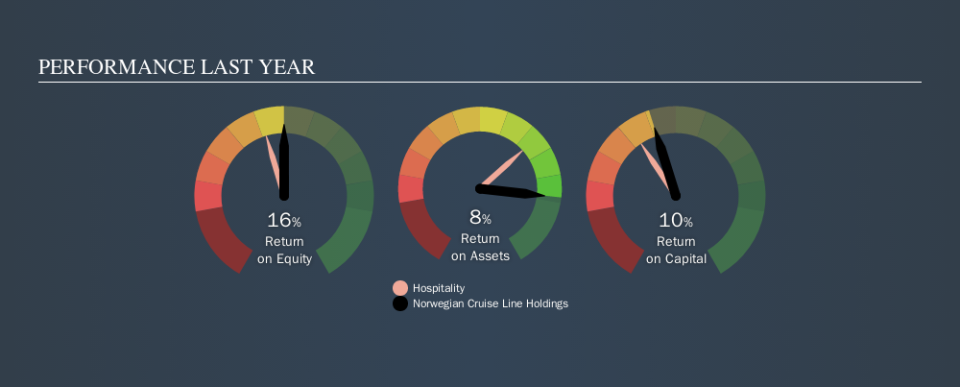What Does Norwegian Cruise Line Holdings Ltd.’s (NYSE:NCLH) 9.9% ROCE Say About The Business?

Today we are going to look at Norwegian Cruise Line Holdings Ltd. (NYSE:NCLH) to see whether it might be an attractive investment prospect. Specifically, we'll consider its Return On Capital Employed (ROCE), since that will give us an insight into how efficiently the business can generate profits from the capital it requires.
First, we'll go over how we calculate ROCE. Next, we'll compare it to others in its industry. Then we'll determine how its current liabilities are affecting its ROCE.
Understanding Return On Capital Employed (ROCE)
ROCE is a metric for evaluating how much pre-tax income (in percentage terms) a company earns on the capital invested in its business. In general, businesses with a higher ROCE are usually better quality. Overall, it is a valuable metric that has its flaws. Author Edwin Whiting says to be careful when comparing the ROCE of different businesses, since 'No two businesses are exactly alike.
So, How Do We Calculate ROCE?
The formula for calculating the return on capital employed is:
Return on Capital Employed = Earnings Before Interest and Tax (EBIT) ÷ (Total Assets - Current Liabilities)
Or for Norwegian Cruise Line Holdings:
0.099 = US$1.2b ÷ (US$16b - US$3.6b) (Based on the trailing twelve months to June 2019.)
Therefore, Norwegian Cruise Line Holdings has an ROCE of 9.9%.
View our latest analysis for Norwegian Cruise Line Holdings
Is Norwegian Cruise Line Holdings's ROCE Good?
ROCE can be useful when making comparisons, such as between similar companies. Using our data, Norwegian Cruise Line Holdings's ROCE appears to be around the 8.6% average of the Hospitality industry. Setting aside the industry comparison for now, Norwegian Cruise Line Holdings's ROCE is mediocre in absolute terms, considering the risk of investing in stocks versus the safety of a bank account. It is possible that there are more rewarding investments out there.
The image below shows how Norwegian Cruise Line Holdings's ROCE compares to its industry, and you can click it to see more detail on its past growth.
Remember that this metric is backwards looking - it shows what has happened in the past, and does not accurately predict the future. Companies in cyclical industries can be difficult to understand using ROCE, as returns typically look high during boom times, and low during busts. ROCE is, after all, simply a snap shot of a single year. Since the future is so important for investors, you should check out our free report on analyst forecasts for Norwegian Cruise Line Holdings.
How Norwegian Cruise Line Holdings's Current Liabilities Impact Its ROCE
Current liabilities include invoices, such as supplier payments, short-term debt, or a tax bill, that need to be paid within 12 months. Due to the way the ROCE equation works, having large bills due in the near term can make it look as though a company has less capital employed, and thus a higher ROCE than usual. To counter this, investors can check if a company has high current liabilities relative to total assets.
Norwegian Cruise Line Holdings has total assets of US$16b and current liabilities of US$3.6b. As a result, its current liabilities are equal to approximately 22% of its total assets. This very reasonable level of current liabilities would not boost the ROCE by much.
The Bottom Line On Norwegian Cruise Line Holdings's ROCE
That said, Norwegian Cruise Line Holdings's ROCE is mediocre, there may be more attractive investments around. Of course, you might find a fantastic investment by looking at a few good candidates. So take a peek at this free list of companies with modest (or no) debt, trading on a P/E below 20.
If you like to buy stocks alongside management, then you might just love this free list of companies. (Hint: insiders have been buying them).
We aim to bring you long-term focused research analysis driven by fundamental data. Note that our analysis may not factor in the latest price-sensitive company announcements or qualitative material.
If you spot an error that warrants correction, please contact the editor at editorial-team@simplywallst.com. This article by Simply Wall St is general in nature. It does not constitute a recommendation to buy or sell any stock, and does not take account of your objectives, or your financial situation. Simply Wall St has no position in the stocks mentioned. Thank you for reading.

 Yahoo Finance
Yahoo Finance 
